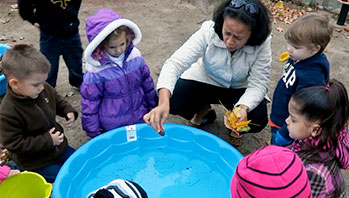- clipboards
- icon pictures of things that make outdoor sounds (person, animal, car, machine, bird, rain, etc.)
- markers or crayons
- paper
- hear
- listen
- quiet
- sound
- source
MA Standards:
Language/L.PK.MA.6: Use words and phrases acquired through conversations, listening to books read aloud, activities, and play.
Head Start Outcomes:
Logic and Reasoning/Reasoning and Problem Solving: Recognizes cause and effect relationships.
Logic and Reasoning/Reasoning and Problem Solving: Classifies, compares, and contrasts objects, events, and experiences.
PreK Learning Guidelines:
Science and Technology/Living Things and Their Environment 15: Use their senses of sight, hearing, touch, smell, and taste to explore their environment using sensory vocabulary.
Science and Technology/Inquiry Skills 4: Record observations and share ideas through simple forms of representation such as drawings.
Mathematics/Number Sense 1: Listen to and say the names of numbers in meaningful contexts.
Explore Together (outdoors): Sound Map

© Commonwealth of Massachusetts, Department of Early Education and Care. All rights reserved.
STEM Key Concepts: Sounds have a source (A sound can be tracked to its source); An action has to happen to make a sound; Different objects make different sounds; Sounds vary in three ways: volume, pitch, and timbre
ELA Focus Skills: Listening and Speaking, Counting, Vocabulary
Educator Prep: On chart paper draw a simple map of the outside area that children will explore. Be sure to include familiar landmarks that children will recognize (playground, tree, sand box, etc.)
Display the map and discuss the area outside where children will explore. Say,
- This is a map of the area outdoors that we will explore.
- Do you see the <sandbox>? That is where we will go to first to begin listening to sounds.
Then bring children outside to the <sandbox>. Encourage children to write or draw their observations on one of the clipboards. Tell children this will help them record and recall what they observed.
Once outside, talk about different sounds children might hear, such as people, animals, machines, etc. Then have children listen quietly. After one minute, have children take turns answering questions such as,
- Can you describe one sound you hear?
- Do you know where is that sound coming from?
- What do you think is the source of that sound?
Allow time for children to dictate or record their responses. Track the sound to its source (or as closely as possible.) Then ask, What happens to the sound when we get closer it to its source? (gets louder) Tape a representative icon picture of the object that made the sound in that area on the map.
- Have children explore areas on the map in small groups (or pairs) and record their sounds on the map as they explore. Allow groups or pairs to choose the area on the map that they want to explore next. Allow children to freely explore listening for, identifying, and tracking sounds (if possible.)
- Be available to prompt quiet listening before exploring, elicit discussions when something sparks a group’s interest, encourage children to ask questions about their observations, or help children document their findings on the map.
- Once groups have explored all the areas of the map, bring children inside and have them share their observations.
Reflect and Share
- Draw attention to the map and say, Let’s look at the map and see what types of sounds we heard the most? The least?
- Engage children in reflection on why they heard more sounds of one type than of others. Help children relate types of sounds to the places they were coming from.
- Then ask groups (pairs) to use the map as they share their observations with the group.
